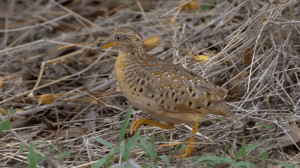TAG: GS 3: ECOLOGY AND ENVIRONMENT
THE CONTEXT: The yellow-legged buttonquail, an elusive and uncommon breeding migrant bird, was recently spotted in the urban areas of Bopal-Ghuma in Ahmedabad city.
EXPLANATION:
- The yellow-legged buttonquail (Turnix tanki) is a small, ground-dwelling bird typically found in grasslands and scrublands.
- It is not commonly seen in urban areas. The sighting of this bird in the Vastrapur area of Ahmedabad is considered significant.
- Experts suggest that the buttonquail’s presence in the urban area could be due to habitat loss or disturbance in its natural grassland habitats.
Conservation
- The International Union for Conservation of Nature (IUCN) classifies the yellow-legged buttonquail as a Least Concern species.
- However, its populations are declining due to habitat loss and hunting.
- This sighting highlights the importance of urban green spaces in providing refuge for wildlife.
Yellow legged Buttonquail
- The yellow-legged buttonquail (Turnix tanki) is a buttonquail, one of a small family of birds that resemble true quails but are unrelated to them.
- This family is peculiar in that the females are larger and more colourful than the males and are polyandrous.
- It belongs to the family Turnicidae.
- This species is native to various habitats across the Indian subcontinent, EastAsia, and Southeast Asia, adapting well to the local environments.
- It has two subspecies: T. t. tanki in Pakistan, India, Nepal, and the Andaman and Nicobar Islands; and T. t. blanfordii in Myanmar, Indochina, and eastern China.
- It also migrates to the Korean peninsula and parts of southeast Russia.
- The yellow-legged buttonquail is a small quail that grows to 15 to 18 cm (6 to 7 in). The females are slightly larger and more brightly coloured than the males.
- The weight is 36 to 43 g (1.3 to 1.5 oz) for the subspecies Turnix t. tanki, and 35 to 78 g (1.2 to 2.8 oz) for the male Turnix t. blanfordii, while the female of this subspecies is 93 to 113 g (3.3 to 4.0 oz).
- The tail is short, and the wings have rounded ends.


